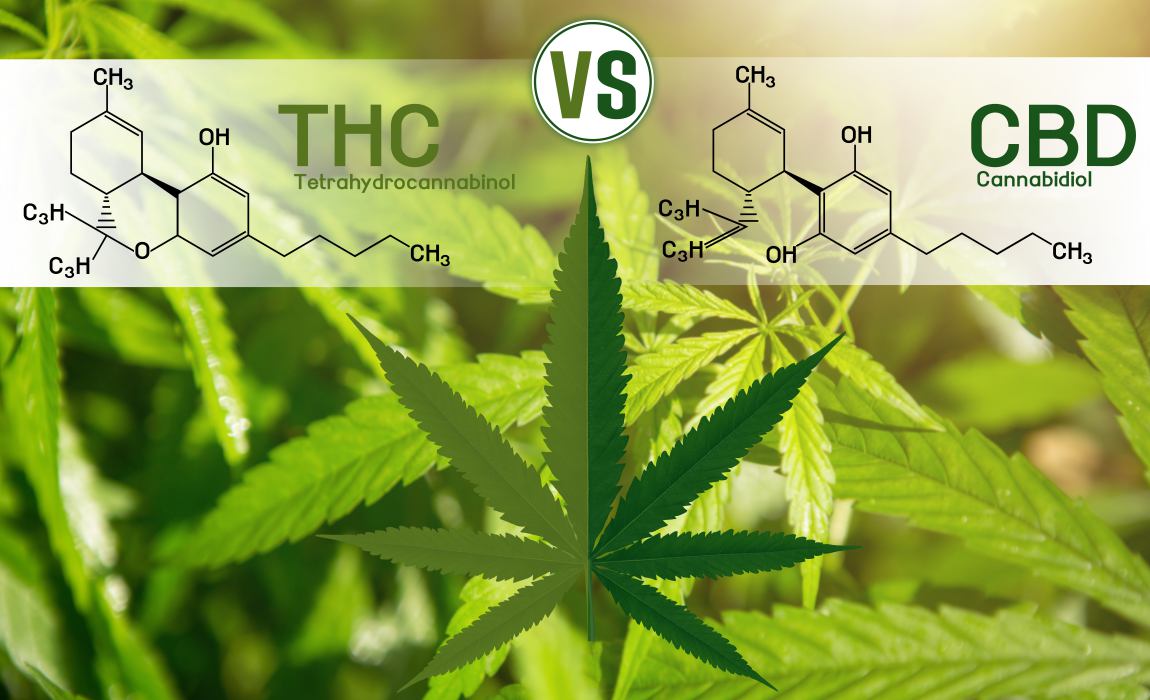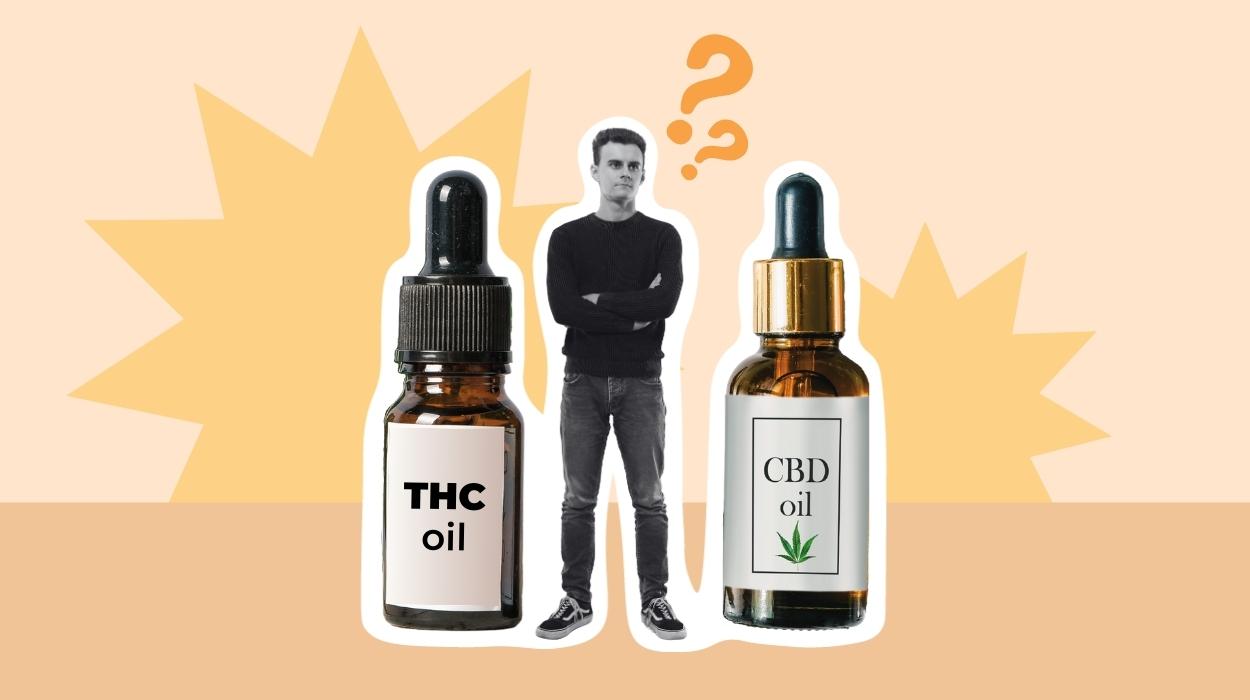Differences Between CBD And THC: How To Maximize Benefits In 2024
Cannabis Sativa, also known as marijuana, is a complex plant that contains many biological compounds–called cannabinoids. The two most prominent cannabinoids are THC and CBD. These compounds have different effects on the body and mind and are subject to various legal regulations.
This article will explain the key differences between CBD and THC, including their chemical structures, psychoactive effects, health benefits, potential side effects, drug testing, and legality.
Differences Between THC And CBD

Consuming the chemical compounds in cannabis can affect your body’s endocannabinoid system.[1] This system plays a vital role in maintaining homeostasis in the body, managing the complex equilibriums of blood sugar levels, body temperature, hunger, blood pressure, and more. However, every cannabinoid is a bit different.
Chemical Structure
The chemical structures of THC and CBD are different. CBD is composed of a 21-carbon atom chain with a carboxyl group at the end. THC comprises a 21-carbon atom chain with a hydroxyl group at the end. The presence of this hydroxyl group causes THC’s psychoactive properties.
Psychoactive Properties
THC binds to cannabinoid receptors in the brain, producing euphoric or intoxicated sensations associated with marijuana use. On the other hand, CBD has become famous in recent years due to its remarkable medical promise without the “high” of THC.
Benefits Of Both CBD And THC
Both CBD and THC are associated with various medical benefits. For example, full-spectrum CBD products and THC affect multiple conditions, such as anxiety, depression, pain, and inflammation. They may also have neuroprotective properties, with the ability to treat rare and severe forms of brain disease such as epilepsy, Parkinson’s, and Multiple Sclerosis (MS).
Chemical compounds derived from cannabis are valuable tools in complementary and integrative health. More research[2] gets published every day as medical cannabis becomes more widely available.
Potential Side Effects
The World Health Organization has stated that CBD is generally considered safe and well-tolerated. However, some people may experience side effects such as drowsiness, dry mouth, and changes in appetite.
THC can also cause potential side effects such as paranoia, anxiety, and increased heart rate. In high doses, THC can also cause hallucinations and delusional thinking. Additionally, smoking or vaping THC[3] may also have adverse effects on lung health.
Drug Testing
THC can be detected in a standard drug test, while CBD typically cannot. Most standard drug tests are specifically designed to detect THC because it’s the compound that causes intoxication.
Despite the 2018 Farm Bill, which legalized hemp-derived CBD products with a THC content of 0.3% or less in the US, CBD products may still contain more THC[4] than the label states. Therefore, it’s essential to purchase CBD products from reputable sources and be aware of the THC content if you are subject to drug testing. Even if marijuana is legal according to your state laws, employers can still hold a positive test against you.
Legality
The legal status of CBD and THC can vary depending on where you live. Cannabis consumers should always stay up-to-date on their local laws. The US government’s Controlled Substances Act means that technically speaking, THC-containing products are not legal to grow, sell, or possess for any reason under federal law.
However, many states in the US have laws legalizing and decriminalizing cannabis while also opening up state medical cannabis laws. As a result, the laws in every state are different, and they often run contrary to federal policy. These policies create industry challenges, including no banking access, no trade across state lines, and no centralized quality control.
The policies in the rest of the world vary widely, but they usually fall into one of 5 categories:
- Illegal. In these states and countries, hemp is illegal in every form, even if it doesn’t contain THC.
- CBD-only. In these states and countries, hemp-derived CBD is legal, but marijuana is still illegal.
- Decriminalized. In these states and countries, possessing small amounts of THC is not considered a criminal offense. It is still technically illegal, so getting caught with it can generate small fines.
- Medical Marijuana Programs. The medical community accepts cannabis to treat certain medical conditions such as chronic pain, epilepsy, and PTSD. Certain governments have permitted marijuana to enter the market.
- Fully Legal for Recreation. These states and countries have systems to legally grow, sell, and tax cannabis for casual use by adults.
What Is THC?
THC, or tetrahydrocannabinol, is the main psychoactive compound and active ingredient derived from the Cannabis Sativa plant. It is responsible for the “high” associated with marijuana use. THC has potential therapeutic benefits,[5] such as reducing pain[6] and nausea.[7] It also appears to have anti-inflammatory properties and has been used to treat conditions such as cancer[8] and HIV/AIDS.[9]
However, it’s important to note that excessive use of THC can lead to adverse side effects. Recorded side effects range from mild, such as increased appetite and dry mouth, to severe, such as mental health conditions and substance abuse. The research[10] is ongoing.
What Is CBD?
CBD, or cannabidiol, is a non-psychoactive compound found in cannabis plants. Unlike THC, CBD does not cause the intoxicating effects commonly associated with cannabis use. This feature makes it more widely used for its potential medicinal benefits,[11] such as managing pain, anxiety, and inflammation. It’s possible to derive CBD from hemp, a non-psychoactive variety of the cannabis plant. Hemp-derived CBD oil and other broad-spectrum CBD products are not subjected to the Controlled Substances Act as long as the THC content is below o.o3%.
The Difference Between Cannabis, Hemp, And Marijuana
You’ve probably heard the terms hemp, cannabis, and marijuana used interchangeably, but they usually refer to different things.
- Cannabis refers to the plant species as a whole, which includes both hemp and marijuana varieties.
- Hemp refers to low-THC cannabis plants explicitly grown for industrial use.
- Marijuana refers specifically to high-THC cannabis grown for its psychoactive effects.
Cannabis potency varies widely between different breeds. In most countries, marijuana is still illegal. Hemp, on the other hand, is used in various products, such as textiles, paper, and food, and is, therefore, more widely available.
Similarities Between THC And CBD
Benefits
CBD and THC have potential therapeutic benefits that can help with various conditions. CBD and THC interact with the body’s endocannabinoid system. This system[12] is responsible for maintaining homeostasis in the body. This interaction can provide pain relief, mood stabilization, and the reduction of inflammation. In addition, both CBD and THC seem to have anti-tumor[13] properties, making medical cannabis a potential cancer treatment.
Ingestion Methods
Various ways to consume CBD and THC include inhalation, oral ingestion, and topical application.
Inhalation
Smoking involves burning dried marijuana and inhaling the smoke. Vaping is smokeless inhalation achieved with various methods. These methods include air extraction (blowing hot air over the plant material and catching the vapor for inhalation) or warming THC or CBD isolate in an e-cigarette.
Smoking and vaping are the most popular methods of consumption because they are cheap, provide results quickly, and foster community when consumed in groups. In addition, these methods are ideal for treating nausea, seizures, migraines,[14] or anxiety.[15] However, you should avoid these methods if you have lung conditions or respiratory problems. The jury is still out on whether or not the medical benefits of inhaling cannabis products are worth the risk of lung damage.
Oral Ingestion
In contrast, oral preparations such as tinctures, edibles, and capsules can take longer to kick in but have a longer-lasting effect. Tinctures are liquid extracts that you can place under the tongue for fast absorption. Edibles involve cooking extracts into food. Finally, capsules deliver cannabis extract in pill form, allowing precise dosing with no smell or mess.
Eating cannabis is ideal for long-lasting, extended use, particularly if you need potent doses. In addition, individuals seeking help with inflammation, chronic pain, or treating a major illness prefer this method.
Topical Application
There has been an explosion of cannabis products designed for topical use, particularly hemp-derived preparations. These methods are great for individuals who want the benefits of THC without the high. It’s also the best way to use the medication for skin, muscle, and joint conditions.
The Entourage Effect
The Entourage Effect is a phenomenon that suggests that the various compounds found in the cannabis plant, including CBD and THC, can work together[16] to enhance their potential therapeutic effects. In addition, this theory indicates that CBD can modulate the psychoactive effects of THC and vice versa.
The idea is that CBD can reduce the anxiety and paranoia that THC can sometimes cause. At the same time, THC can enhance CBD’s potential pain-relieving and anti-inflammatory effects. Other compounds in the cannabis plant, such as terpenes and flavonoids, are also thought to contribute to the entourage effect.
Combining these different compounds is believed to create a more balanced and beneficial effect on the body and mind. As a result, a growing market of smokeless cannabis-related products applies the research[17] concerning these topics.
Conclusion
CBD and THC are two of the most well-known compounds in the Cannabis Sativa plant. Understanding the differences and similarities between CBD and THC is necessary to make informed decisions about cannabis use. Ignorance of the law does not prevent unwanted consequences. It’s also essential to stay up-to-date with regulations and policies, particularly if you’re traveling internationally.
Frequently Asked Questions
Typically, no. However, in rare cases, high doses of CBD can contain trace amounts of THC, which can lead to a positive drug test[18].
THC is still illegal in many states and countries, but some places have legalized or decriminalized it.
Hemp-derived CBD oil with a THC content of less than .03% is legal in most places. There is even an FDA-approved CBD product designed for certain types of seizures.
Yes, CBD and THC can be consumed together and occur in the plant together. It’s believed that either chemical works better in the presence of the other, known as the u0022entourage effect.u0022 This theory suggests that CBD can reduce the adverse effects of THC and vice versa.
 Expert's opinion
Expert's opinion
